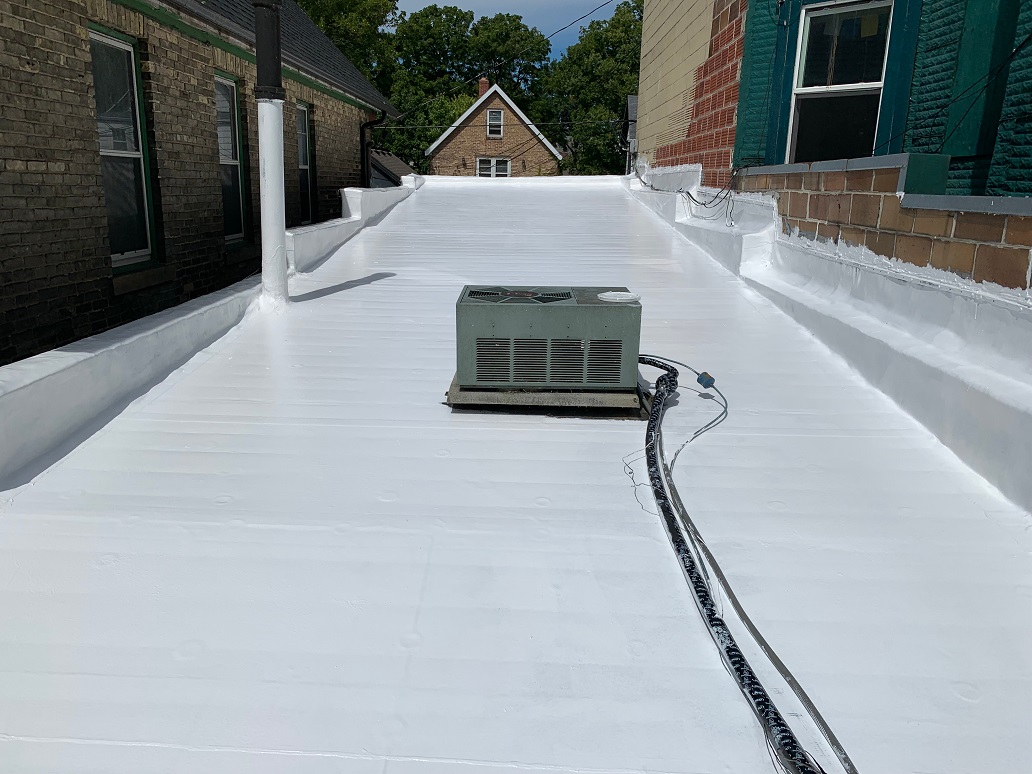Everything you need to know about liquid roof coating
Liquid roof coating for repairing and protecting your roof
What is liquid roof coating?
A liquid roof coating is a product used to protect a building's roofing and extend its lifespan. It is applied as a thin layer that covers and protects the roof from various elements such as rain, wind, sun and other natural factors that can damage the roof.
In this article, we will go into more detail about which liquid roof coatings are available, the advantages and disadvantages of liquid roof coatings as well as what they are suitable for.

Advantages of liquid roof coatings
There are several advantages to using liquid roof coatings:
- Waterproofing: Liquid roof coatings provide excellent waterproofing that protects the flat roof from leaks and water damage. They create a seamless layer that repels water and prevents it from penetrating under the roofing.
- Durability: Liquid roof coatings are durable and last longer than traditional roofing materials such as bitumen, slate or tiles. They are resistant to extreme weather conditions, UV radiation and abrasion.
- Energy efficiency: Liquid roof coatings sometimes have reflective properties that reflect the sun's heat instead of absorbing it. This can lead to cooler building interiors and reduced energy costs for air conditioning.
- Easy installation: Liquid roof coatings are easy to apply and require no special tools or equipment. They can be applied by spray, roller or brush and are usually ready to use.
- Ease of maintenance: Liquid roof coatings require little maintenance and can be easily cleaned with water and a mild detergent.
Types of liquid roof coatings
Liquid roof coatings are popular for flat roofs and offer durability and flexibility against various weather conditions. They are suitable for bitumen, EPDM, PVC, TPO, zinc, lead, wood and metal, and can be applied with a brush, roller or spray gun. In addition, liquid roof coatings are also available in several varieties such as acrylic, silicone and polyurethane, each with their own advantages and disadvantages. Choosing the right product depends on the surface to be treated, the environment and the level of protection desired.
- Liquid elastomeric roof coating
One of the most popular types of roof coatings is the elastomeric coating. This roof coating can be applied to different types of surfaces, including concrete, wood and bitumen. This coating has high elasticity, meaning it can expand and contract without cracking or tearing. This allows the coating to be applied to surfaces subject to temperature changes without damaging them. - Liquid acrylic roof coating
Acrylic roof coatings are popular because of their durability, flexibility and ease of use. They can be applied to different types of roofing materials, such as metal, concrete and bitumen. Acrylic coatings are also resistant to UV radiation and discolouration. Since they protect the roof surface against harmful effects of the sun, the lifespan of the roof is extended. However, acrylic roof coatings have limited resistance to standing water, but will protect the roof surface from rain, snow and hail. They are also easy to apply as they are usually available as a 1-component product that is ready to use immediately. - Liquid silicone roofing
Silicone (STP) or MS polymer roof coatings are excellent for flat roofs because of their waterproofing, high elasticity and durability. They are resistant to extreme temperatures and UV radiation and are ideal for buildings exposed to a lot of expansion. These products also offer a solution for zinc or lead gutters as well as have an adhesion to (some) EPDM rubbers. Silicone roof coatings are also resistant against standing water on the roof and in roofgutters. Silicone roof coating is more flexible than acrylic roofing and can therefore bridge cracks or fissures when exposed to large temperature fluctuations. - Liquid polyurethane roof coatings
PU or PUR roof coatings are a durable and water-resistant option as liquid roof coatings. They are usually tough, flexible and resistant to abrasion, so ideal for roofs that are frequently walked on, such as parking decks, walkways and balconies. Thanks to the addition of quartz sand, you obtain a wear-resistant and non-slip surface.
Liquid polyurethane roof coatings have rather limited resistance to UV rays and can protect the roof surface from the harmful effects of the sun. Polyurethane roof coatings are also resistant to water and can protect the roof surface from rain, snow and hail. However, they are not as flexible as acrylic or silicone roof coatings and can potentially crack or tear when exposed to temperature fluctuations if not reinforced with fibre reinforcement. - Liquid bitumen roof coatings
Bitumen roof coatings are UV-resistant and have excellent adhesion to old bitumen or roofing. The major advantage of these products is their insensitivity to moisture during processing. These bituminous topcoats come in several varieties, including elastomeric bitumen or plastomeric bitumen. These can be SDS-based, APP-based or a combination of the two.


Why choose a liquid roof coating?
Liquid roof coatings offer several advantages over traditional roofing materials. For instance, a liquid roof coating allows you to waterproof the roof or gutter by covering it completely without seams or other weak spots.
With a seamless coating, it reduces the risk of leaks, wear and other damage and extends the lifespan of the surface. Moreover, seamless coating can be applied to different types of roofs, including bituminous, concrete, lead or zinc roofs. It can be done in different colours and finishes, making it possible to match the appearance of the roof or gutter to the style of the building.
How to apply liquid roofing?
Applying a seamless coating to a flat roof or gutter starts with cleaning the surface. This is important to ensure that the coating adheres well to the surface and to remove dirt that could reduce the life of the coating. After cleaning the surface, the coating is applied using a roller, spray gun or other suitable tool.
Learn more about elastic roof coatings
Feel free to contact us to receive more info about our products or read more about elastic coatings here.
